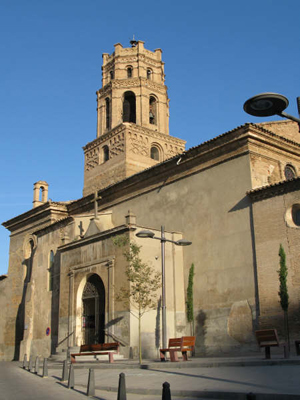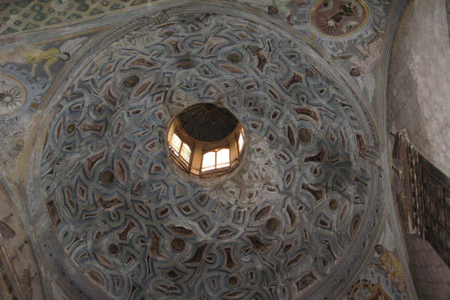 |
||||||||||
 |
||||||||||
|
1513: Cathedral of Santa Maria del Romeral, Monzón,
Aragon, Spain Mystery Worshipper: Augustine the Aleut. The church: Cathedral of Santa Maria del Romeral, Monzón, Aragon, Spain. Denomination: Roman Catholic, diocese of Barbastro-Monzón. The building: This co-cathedral was consecrated by Bishop Raimundo Dalmacio in 1098 after the city was taken from the Moors, and served as a collegiate church until its appointment in 1995 as cathedral church of the diocese. Most of it was built in the 12th and 13th centuries. Much of the stonework is Moorish in style, with a stone ceiling patterned with exuberant geometric and floral decoration, likely built by Mudéjars (the Muslims who stayed on after the re-conquest by Christian forces). The nave is short and the transepts long, to the point it is almost cruciform in its layout. Sad to say, many of the cathedral's treasures disappeared during one of Spain's civil wars in 1642. The Aragonese parliament met here from the 13th to the 17th centuries. The church: The diocese of Barbastro-Monzón came into being in 1995, the culmination of hundreds of years of squabbling and redistricting by church and state alike in an attempt to bring diocesan boundaries into conformity with ethnic and territorial boundaries. Litigation continues to this day over possession of various properties and art treasures. The diocese forms part of the ecclesiastical province of Zaragoza, and is thus suffragan to the archdiocese of Zaragoza. The neighbourhood: The cathedral faces onto a plaza in the old medieval part of Monzón, with only two or three shops and cafés. To the northeast one finds a district recently populated by Muslims from Morocco and north Africa. Monzón has no mosque, but there is apparently a storefront Christian evangelical congregation recently established by a mission from England, the only sign I have ever seen in Spain of non-RC Christianity. The hulking Templar castle looms over the old own. The cast: Good question... the priest was in his mid-60s and was vested in a plain green chasuble with a black orphrey. The date & time: Monday, 10 September 2007, 7.00pm. What was the name of the service? Mass. How full was the building? When full, it might hold about 300-400, but there were only about 40 of us at a weekday evening mass. I was the only pilgrim (indeed, in 15 days I only saw two others on the fairly unpopulated camino out of Montserrat) and, by the curious glances of congregants, might well have been the only new face they had seen for some time. Did anyone welcome you personally? No. Was your pew comfortable? It wasn't bad, really. I have found that older pews in Spain appear to have been designed for lounging. How would you describe the pre-service atmosphere? Still, and with voices echoing from the entrance and the plaza beyond. At early evening, the stone pavement and walls were still radiating heat from the day. The very properly dressed congregants greeted each other quietly and went to their pews. One of the women stood at the front and, after brief comments, began to lead the congregation in saying the Rosary for the next ten minutes. I found the rhythm of the petitions soothing, and let my mind drift until the priest arrived. What were the exact opening words of the service? En el nombre del Padre, y del Hijo, y del Espíritu Santo. What books did the congregation use during the service? None. Everybody seemed to know the service by heart. This seems to be common in Spain and, with nothing to read in the pew, there is little distraction. What musical instruments were played? None, although the congregants sang part of the post-communion prayers a cappella. Did anything distract you? I enjoyed looking at the swirling pattern on the ceiling above. Then my eyes drifted toward an olive-skinned, dark-eyed young woman sitting nearby with a Moleskin notebook and a cell phone that occasionally bounced up and down with incoming calls. Was the worship stiff-upper-lip, happy clappy, or what? It had an interesting blend of relaxed formality, which is part of life in a group of people who likely knew each other well and for a long while.  Exactly how long was the sermon? 7 minutes – short as befits a weekday evening mass. On a scale of 1-10, how good was the preacher? 8 – I think I understood the Castilian fairly well, as the priest spoke very clearly and simply, perhaps because he had spotted a pilgrim in the congregation with a brain fried from walking in the afternoon sun. He may have had dramatic training, as he could cast his voice into a largish building without microphone and without distorting the sound. In a nutshell, what was the sermon about? Forgiveness is an essential part of Christianity. We rely on the Lord's forgiveness and cannot count on coming to the heavenly banquet on account of our own merits and our good looks (I think I translated correctly). We should make a point of expressing forgiveness every day to someone who has offended us. In this way, our lives could become a school for ourselves and others around us. Which part of the service was like being in heaven? The periods of silence before and after prayers. The quiet friendliness of congregants to this stranger in their midst. And which part was like being in... er... the other place? Nothing really, although I was a bit discomfited by all of the pearls, jewelry and coiffures. What happened when you hung around after the service looking lost? I studied a few of the monuments and inscriptions around the wall by the entrance. Soon the prayer leader came up to say hello and shake my hand. She was followed by several others who came up to wish me a good voyage. Just before I left, I was distracted by a more modern notice and went up to read a plaque asking parishioners to pray for the beatification of the church's two curates, José Nardal and José Jordan, martyred on August 12, 1936, at that spot. There were two fuzzy blown-up photographs of the two young priests, one clearly overweight and cheerful, and the other square-headed and short-haired and staring at me through the camera's lens. I was taken aback and, in the empty church, stepped back away from the spot, whereupon I saw a small bouquet of red flowers underneath the notice. How would you describe the after-service coffee? I do not think that this is the practice here, so I wandered out into the square and ordered a drink at one of the cafés (it was only 8.00pm and the restaurants would not open for another hour). I sat there and enjoyed the falling of the velvet indigo of a September evening in Spain, looking at the stars over the Templar castle. I thought all the while of those two young clerics and what strange storm of politics and religion and violence brought them to their end. In the plaza, people were just beginning their paseo (the strolling around the square before the evening meal). I noted the older people who would have been children when the two priests died, and who were possibly catechized by them, and the teenagers in skin-tight clothing talking to each other across the square on their cell phones, and wondered of the world between these two Spains. How would you feel about making this church your regular (where 10 = ecstatic, 0 = terminal)? 8 – I would go back again, but I have no idea if I will ever be in Monzón again in this life. Did the service make you feel glad to be a Christian? It was a moment of peace and coolness after a burning day of 23 kilometres on a dusty plain. What one thing will you remember about all this in seven days' time? The start I had when I realised that I was standing at the spot where the two young priests were martyred. This does not only happen in books. More Camino reports |
|
|
||||||||||||||||||||||||||||||||||||
| More Mystery Worshipper reports | |||||||||||||||||||||||||||||||||||||||
 |
|||||||||||||||||||||||||||||||||||||||






